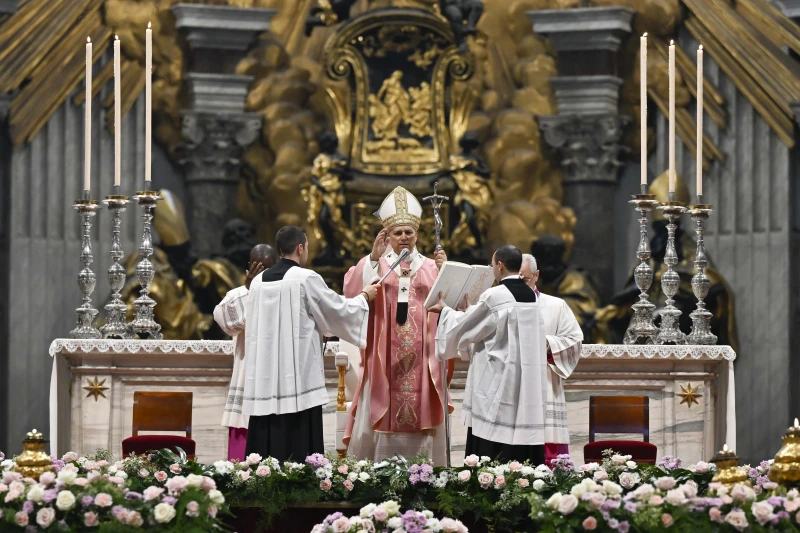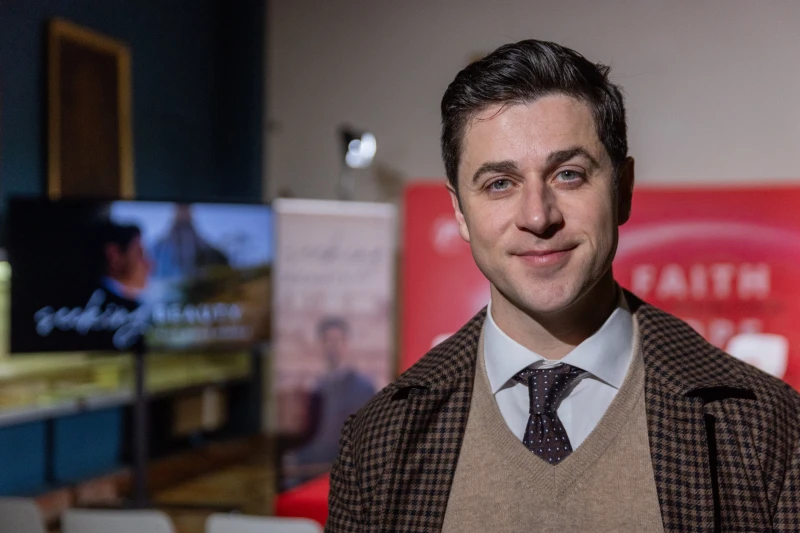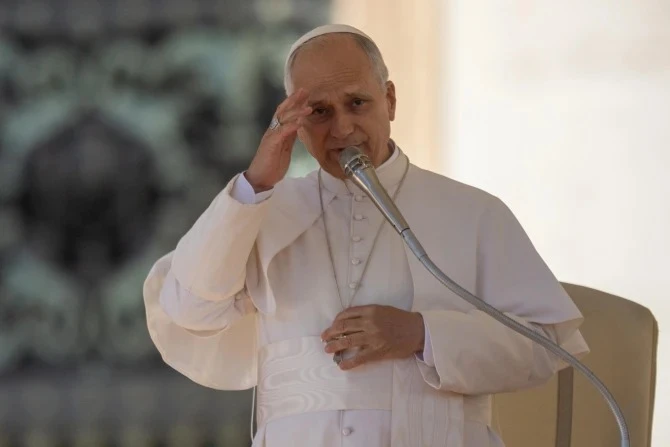Posted on 12/16/2025 20:11 PM (CNA Daily News - Vatican)
 Pope Leo XIV presides at the jubilee Mass for prisoners on Dec. 14, 2025. / Credit: Vatican Media
Pope Leo XIV presides at the jubilee Mass for prisoners on Dec. 14, 2025. / Credit: Vatican Media
ACI Prensa Staff, Dec 16, 2025 / 15:11 pm (CNA).
The last major event of the Jubilee of Hope was dedicated to prisoners around the world, some of whom during the past weekend were able to experience freedom and fulfill a dream: to go see Pope Leo XIV.
Víctor Aguado, director of prison ministry in Valencia, Spain, accompanied a group of prisoners to the Eternal City, many of whom had spent more than 12 years behind bars. Thanks to special permission, they were able to travel and become living witnesses that “hope breaks down walls and that dignity cannot be taken away.”
In a conversation with ACI Prensa, CNA’s Spanish-language news partner, Aguado recounted the details of the “intense, emotional, and spiritual” trip that will forever mark the lives of the men and women who have been incarcerated.
The group was composed of a total of 13 people from Valencia, including prisoners, volunteers, and the chaplain. Six of them were inmates in the second and third degree of the prison system — regimens that combine incarceration with controlled outings — so they had to obtain a series of permits from the Treatment Board, the General Secretariat, and the Oversight Institutions. “It was a long bureaucratic process, but we didn’t have any problems,” Aguado explained.
He explained that they selected the prisoners they have known for a long time. Those in the third degree of the prison system enjoy a semi-release regimen and live in halfway houses, while those in the second degree usually go to workshops and cooperate with everything the prison ministry proposes. “They are people of faith who attend Mass, and we knew that, given their situation and attitude, they needed this and wouldn’t turn it down,” he commented.

“They wanted to be very well prepared, free of burdens, and participate in Sunday Mass completely cleansed and at peace with themselves,” said Aguado, who also highlighted their passing through the Holy Door as one of the most emotional moments of the jubilee. “With the pilgrimage, the prisoners assumed a new responsibility and a new path, a new life, and the feeling that now they have to do things right.”
He also highlighted their excitement at seeing the pope, since for them “he is the representation of the Lord on earth.” The Sunday Mass with the Holy Father, Aguado explained, was “very simple, and although it was in Italian, it was perfectly understandable.”
“Hope goes beyond, it breaks down walls wherever it may be, and the dignity of people cannot be taken away, and that is what they conveyed during the three days we were in Rome. These were very intensely personal experiences, and we could feel their joy; everyone had a look of peace,” he noted.
For Aguado — who has been working with prisoners for 14 years — the fact that this event closed the Jubilee of Hope is no mere coincidence. “The world of prisons is not visible, and in some way we must begin to consider that people who have been judged eventually get out and have to reintegrate into normal life, and that depends on society.”
“We know that the Lord forgives everything, so who are we to not forgive these people and keep on stigmatizing them? They are called ex-convicts, but they are nothing more than persons, with all their dignity and freedom,” he affirmed.
Although he assured that the Lord “is always with them and walks with them,” he emphasized the urgency of recognizing the prisoners as living members of the Church and appealed to the responsibility of every Christian: “Sometimes we take the works of mercy for granted, but we don’t always put them into practice. The Lord challenges us: ‘I was in prison,’ and the question remains the same: ‘Did you come to see me?’”
The Italian priest Father Raffaele Grimaldi, who left his chaplaincy at the Secondigliano prison in Naples — where he served the inmates for 23 years — to coordinate the 230 priests who minister to the nearly 62,000 detainees throughout Italy, also participated in this historic jubilee.
Speaking to ACI Prensa, he noted that the event “is a strong reminder that the Church wants to bring God’s love and mercy to prisons, who goes in search of those who are lost.”

According to Grimaldi, this jubilee “has brought to light the most difficult situations we are experiencing in our prisons and the plight of the prisoners” including overcrowding, lack of resources, suicides, neglect, and “above all, the lack of acceptance from society.”
The priest brought some prisoners from different Italian prisons before Pope Leo XIV, especially young people and one man sentenced to life in prison. “It was a moment of great joy for them,” he commented.
“Every prisoner needs to constantly hear a word of mercy: from people who do not judge, who do not point fingers, who do not condemn, but who embrace,” he stated.
He also emphasized that this jubilee has not been an isolated event, since throughout the year there has been spiritual preparation in the correctional facilities, where “proclaiming hope is a powerful message that resonates deeply in the hearts of all.”
Grimaldi admitted that these individuals have “made mistakes” and are serving a sentence for them; however, he urged people to “reach out to them so that they can take up their lives again and change,” with justice accompanied by mercy, “so that justice itself does not become vengeance.”
During his years of service in the prisons, he said he has encountered many people who have traveled on a beautiful spiritual journey, “like a young Albanian man who received the sacrament of baptism on Dec. 12.”
“This makes us understand that in our prisons there are many lives that need to be rescued and helped, because if these opportunities don’t exist, the prisoner dies inside, and we also kill the hope that is in their heart.”
This story was first published by ACI Prensa, CNA’s Spanish-language news partner. It has been translated and adapted by CNA.
Posted on 12/16/2025 17:58 PM (Catholic News Agency)
 St. Januarius (left) and the relic of the blood of St. Januarius. / Credit: Chapel of St. Januarius
St. Januarius (left) and the relic of the blood of St. Januarius. / Credit: Chapel of St. Januarius
ACI Prensa Staff, Dec 16, 2025 / 12:58 pm (CNA).
The miracle of the liquefaction of the blood of St. Januarius, patron saint of the Italian city of Naples, occurred again on Tuesday, Dec. 16.
Posted on 12/16/2025 16:30 PM (Catholic News Agency)
 The Berlaymont building in Brussels, seat of the European Commission. / Credit: EmDee/Wikimedia (CC BY-SA 4.0)
The Berlaymont building in Brussels, seat of the European Commission. / Credit: EmDee/Wikimedia (CC BY-SA 4.0)
EWTN News, Dec 16, 2025 / 11:30 am (CNA).
A drastic cut in EU funding has plunged the Federation of Catholic Family Associations in Europe (FAFCE) into financial crisis, according to the association.
Posted on 12/16/2025 15:45 PM (CNA Daily News - Vatican)
 Catholic actor and director David Henrie speaks with EWTN News after the first episode of his new travel show, “Seeking Beauty,” premiered at the Vatican’s movie theater on Dec. 15, 2025. / Credit: Daniel Ibanez/CNA
Catholic actor and director David Henrie speaks with EWTN News after the first episode of his new travel show, “Seeking Beauty,” premiered at the Vatican’s movie theater on Dec. 15, 2025. / Credit: Daniel Ibanez/CNA
Vatican City, Dec 16, 2025 / 10:45 am (CNA).
The first episode of a new travel show, hosted by Catholic actor and director David Henrie, premiered at the Vatican’s movie theater on Monday evening.
“Seeking Beauty,” which will debut on EWTN’s free streaming platform EWTN+ on Jan. 19, 2026, is a series documenting Henrie’s exploration of the beauty of art and culture in six Italian cities.
Henrie and executive producer Edmundo Reyes, with other crew members, were present for the airing of Episode 1 inside Vatican City on Dec. 15. The premiere was followed by a Q-and-A with Henrie, Reyes, and Peter Gagnon, president of EWTN Studios, moderated by Andreas Thonhauser, chief global officer of EWTN.
“It’s a blessing to be able to play the show at the Vatican, which is where we [filmed] our first episode,” Henrie told EWTN News. “You can’t help but feel grateful, and feel like [it’s] a full-circle moment.”
Catholic actor and director David Henrie shares just how much fun he had while filming his new travel show, "Seeking Beauty," in Italy. 🍷
— Hannah Brockhaus (@HannahBrockhaus) December 16, 2025
The first episode premiered at the Vatican on Dec. 15, and will stream on EWTN+ (via Roku) starting Jan. 19. pic.twitter.com/4GtNvqKycn
In the first episode, Henrie speaks to a range of experts — including art historian Elizabeth Lev and artist Kelly Medford — to learn more about the Vatican Gardens, the Swiss Guard, St. Peter’s Basilica, and St. Peter’s Square.
Reyes called it “such a special moment” to show the first episode of “Seeking Beauty” at the Vatican.
“We can’t wait for people to see it,” he told EWTN News at the event. “I think it’s going to be a great, great evangelization tool.”
Reyes, who had the original idea for the show, recalled visiting Spain with his family four years ago and how it was there he realized how many stories about art and faith have not been shared with a wider audience.
“God put in my heart this desire … Let’s create a travel show that will be more than a travel show, that would help people encounter God through beauty,” he said.
“What David has done is very special, because it’s not about going to places but retraining us or inviting us to contemplate and to look at beauty differently,” Reyes said during the Q-and-A. It’s about “God speaking to us through beauty, and not so much about, ‘Hey, here’s a cool place to visit and to put on your bucket list.’”

The series is produced by EWTN Studios in partnership with Digital Continent and in association with Novo Inspire and Sacred Arthouse.
“Each episode is very unique … There’s so much there that can touch people in different ways,” Gagnon said.
In Season 1, Henrie will also visit Rome, Milan, Venice, Florence, and Subiaco, a place connected to St. Benedict. Season 2 of “Seeking Beauty” recently wrapped filming in Spain.
“I’m not an expert. You’re just seeing it through my eyes,” Henrie told EWTN News.
“The thing that will make this accessible is that you’re not sitting down for a history lesson; it’s a travel show,” he said. “When my wife and I watch travel shows, we have a glass of wine, we hang out, we relax, we watch something. It’s easy consumption, but there’s some medicine under all the sugar.”
Paola Flynn, Vatican correspondent for EWTN Noticias, contributed to this report.
Posted on 12/16/2025 15:00 PM (Catholic News Agency)
 Cardinal Jean-Claude Hollerich, archbishop of Luxembourg, presided over the beatification Mass of the 50 martyrs of the Catholic apostolate, held Dec. 13, 2025, at Notre Dame Cathedral in Paris. / Credit: Daniel Ibáñez/EWTN News
Cardinal Jean-Claude Hollerich, archbishop of Luxembourg, presided over the beatification Mass of the 50 martyrs of the Catholic apostolate, held Dec. 13, 2025, at Notre Dame Cathedral in Paris. / Credit: Daniel Ibáñez/EWTN News
ACI Prensa Staff, Dec 16, 2025 / 10:00 am (CNA).
Cardinal Jean-Claude Hollerich celebrated in Notre Dame Cathedral in Paris the Mass of beatification for 50 Catholic martyrs murdered by the Nazis.
Posted on 12/16/2025 14:00 PM (Catholic News Agency)
 Italian Bishop Antonio Staglianò celebrates a Mass for the Jubilee of Tourism at Rome’s Church of San Salvatore in Lauro on Dec. 15, 2025. / Credit: Kristina Millare/EWTN
Italian Bishop Antonio Staglianò celebrates a Mass for the Jubilee of Tourism at Rome’s Church of San Salvatore in Lauro on Dec. 15, 2025. / Credit: Kristina Millare/EWTN
Rome, Italy, Dec 16, 2025 / 09:00 am (CNA).
About 400 people participated in a Jubilee of Tourism pilgrimage in Rome on Monday evening.
Posted on 12/16/2025 11:00 AM (Catholic News Agency)
 null / Credit: JulieStar/Shutterstock
null / Credit: JulieStar/Shutterstock
EWTN News, Dec 16, 2025 / 06:00 am (CNA).
French Catholic school officials are now issuing a strong warning against the climate of suspicion and political exploitation they have seen develop in recent months.
Posted on 12/15/2025 22:06 PM (CNA Daily News - Vatican)
 Pope Leo admires the Nativity scene that was made in Costa Rica. / Credit: Vatican Media
Pope Leo admires the Nativity scene that was made in Costa Rica. / Credit: Vatican Media
Vatican City, Dec 15, 2025 / 17:06 pm (CNA).
Pope Leo XIV on Monday thanked Costa Rican artist Paula Sáenz Soto for donating a pro-life Nativity scene to the Vatican, named “Gaudium” (“Joy”), which features a pregnant Virgin Mary.
“I thank the Costa Rican artist who, along with the message of peace of Christmas, also wanted to make an appeal for protecting life from conception,” the pope said during the audience he granted Dec. 15 to the delegations that prepared this year’s Christmas tree and Nativity scenes that will adorn the Vatican during the Christmas season.
The artwork from the Central American country has been on display since Dec. 15 in the Pope Paul VI Audience Hall at the Vatican, the large hall where the pope is now holding his Wednesday general audiences so pilgrims don’t have to endure the cold temperatures of the Roman winter in St. Peter’s Square.
In his address, the Holy Father alluded to its composition, mentioning the 28,000 colorful ribbons that symbolize lives saved thanks to the support provided by Catholic organizations to pregnant women in vulnerable situations.
“The scene depicts a life saved from abortion thanks to prayer and the support provided by Catholic organizations to many mothers in difficult circumstances,” Pope Leo XIV noted.
The decorations in St. Peter’s Square — which were unveiled Monday afternoon — have an Italian touch. The chosen tree comes from Val d’Ultimo, one of the most picturesque and lesser-known valleys of South Tyrol in Italy.
Meanwhile, the Nativity scene in St. Peter’s Square comes from the Diocese of Nocera Inferiore-Sarno, one of the oldest in Italy: Its origins date back to the third century, when Nuceria Alfaterna — the ancient Roman city in the Sarno Valley — already had an organized Christian community.
“I thank you for this artistic work that incorporates characteristic elements of your territory,” the pope said, noting that this traditional Nativity scene includes a reproduction of the sixth-century baptistery of St. Mary Major Basilica, one of the best-preserved in the country.
The pope emphasized that this work will be a reminder for pilgrims from all over the world that “God draws near to humanity, entering into our history in the vulnerability of a child.”
“In the poverty of the cave in Bethlehem, we contemplate a mystery of humility and love,” the pope reflected. He also highlighted the figure of the Virgin Mary “as a model of adoring silence,” who treasures in her heart all that she has experienced, while the shepherds glorify God and share what they have seen and heard. In this regard, he emphasized the “need to seek moments of silence and prayer in our lives.”
Regarding the Christmas tree, the pontiff said the large fir tree “is a sign of life and a reminder of the hope that does not fade even in the cold of winter.”
The lights that adorn it, he added, symbolize “Christ, the light of the world,” who comes to “dispel the darkness and guide our path.” In addition to the large fir tree, the forests of South Tyrol have also donated other smaller trees to the Vatican, intended for offices, public spaces, and various areas of Vatican City.
This story was first published by ACI Prensa, CNA’s Spanish-language news partner. It has been translated and adapted by CNA.
Posted on 12/15/2025 14:00 PM (Catholic News Agency)
 The coffin of Cardinal Josef Beran is carried by a horse-drawn carriage toward St. Vitus Cathedral in Prague on April 21, 2018. The cardinal’s remains were repatriated to his homeland 49 years after his death in exile in Rome. / Credit: PetrS./Wikimedia (CC BY-SA 4.0)
The coffin of Cardinal Josef Beran is carried by a horse-drawn carriage toward St. Vitus Cathedral in Prague on April 21, 2018. The cardinal’s remains were repatriated to his homeland 49 years after his death in exile in Rome. / Credit: PetrS./Wikimedia (CC BY-SA 4.0)
EWTN News, Dec 15, 2025 / 09:00 am (CNA).
A Czech prosecutor has moved to “correct an injustice” against Cardinal Josef Beran, who was interned for 14 years by the communist regime.
Posted on 12/15/2025 12:48 PM (CNA Daily News - Vatican)
 Pope Leo XIV gives his apostolic blessing at the end of the general audience in St. Peter’s Square on Nov. 12, 2025. / Credit: Daniel Ibanez/CNA
Pope Leo XIV gives his apostolic blessing at the end of the general audience in St. Peter’s Square on Nov. 12, 2025. / Credit: Daniel Ibanez/CNA
Vatican City, Dec 15, 2025 / 07:48 am (CNA).
Pope Leo XIV on Monday condemned a deadly attack on the Jewish community in Sydney and entrusted the victims to God in prayer.
“Today I wish to entrust to the Lord the victims of the terrorist attack carried out yesterday in Sydney against the Jewish community,” the pope said Dec. 15, referring to a shooting during a Hanukkah celebration at Bondi Beach that left at least 15 people dead and some 40 others injured.
The Holy Father expressed his spiritual closeness to those affected by the violence, which occurred as more than 1,000 people had gathered to mark the start of Hanukkah, also known as the Feast of Lights — one of the most important celebrations in the Jewish calendar.
According to local media reports, two armed assailants opened fire on the crowd, sparking panic and a mass flight toward the beach and nearby businesses. One attacker was killed during the police response, while the second remains in critical condition. Authorities are investigating possible links between the attackers and a jihadist terrorist organization. Among the victims were a child and a Holocaust survivor.
The pope made his remarks during a Vatican audience with delegations that donated this year’s Christmas tree and Nativity scenes for St. Peter’s Square and the Paul VI Audience Hall. During the same encounter, Leo also reflected on the meaning of Christmas, urging the faithful to “let the tenderness of the Child Jesus illuminate our lives.”
Catholic leaders in Australia also responded with prayer and a strong condemnation of antisemitism. Archbishop Anthony Fisher of Sydney called for prayer and invoked the intercession of the Virgin Mary in the immediate aftermath of the Dec. 14 shooting.
This story was first published by ACI Prensa, CNA’s Spanish-language news partner. It has been translated and adapted by CNA.